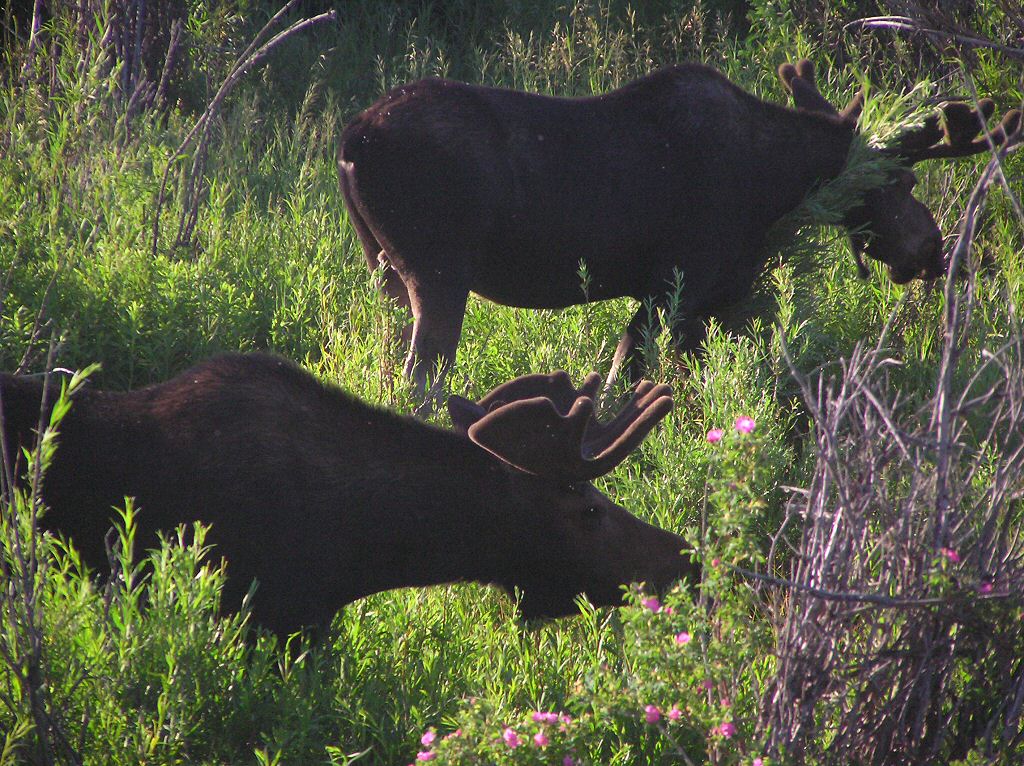|
www.MooreWallpaper.com Tell your friends about us, e-mail them! |
|
North American National Park Moose This photograph of Moose grazing willow shrubs was taken early in the morning along a river bank in Grand Teton National Park in Wyoming. USA. I have been on a number of safaris in Africa and there the advice is always to get up early and go to water holes or river banks if you want to view wild life. The same applies in America. My wife and I left our Jackson Hole Motel early and drove into Grand Teton National Park. We took the first turning on the right after we passed the park entrance. This side road takes you on a circular route along a river basin and back along the grasslands. We parked our car near the river and went for a walk. There is a high river bank with excellent views down to the river and the wooded islands. We used the cover of the bushes and trees on the bluff edge to hide our approach. We were so lucky. We encountered two large male buffalo and four Moose grazing on the far side of the river. The telephoto lens on the camera and a good pair of binoculars were indispensable. We just sat and watched for over an hour. It was a wonderful experience. On the way back to the main road we encountered the main herd of grand Tetonís Buffalo very close to the road. To see them against the backdrop of the grand Teton Mountain range was breath taking. We then went back to the motel for coffee and breakfast. In Yellowstone National Park, Wyoming, USA, Moose are commonly seen in the park's southwestern corner along the Bechler and Falls rivers, in the riparian zones around Yellowstone Lake, in the Soda Butte Creek, Pelican Creek, Lewis River, and Gallatin river drainages, and in the Willow Park area between Mammoth and Norris. Summer moose migrations from south and west of the park into Yellowstone have been confirmed by radiotelemetry Moose have a life span of 15 to 25 years. Moose live mostly solitary lives, and die from disease, starvation, or predation by wolves and, occasionally, by grizzly bears. The introduction of safe National Parks have offered Moose protection from hunting and wolf control programs may have contributed to increased numbers. Moose depend on mature fir forests for winter survival. Forest fires have a damaging effect on their numbers. They eat fir almost exclusively during the deep-snow winter months. They also eat willow, lodgepole pine, gooseberry and buffaloberry. A moose's teeth are specially designed for eating plant materials and for browsing on bushes and small trees. In all they have 32 teeth made up of 12 ridged molars, 12 premolars, 6 incisors and 2 canines. The recent fires that effected a large area of Yellowstone National Park have lead to some older animals dying and the doubling of the normal grazing area in an effort to locate food during the winter. Studies have found that Moose did not recognise the danger of the reintroduced wolf packs and Grizzly bears. They failed to adopt a defensive stance or run unlike the Moose in Alaska that have always had to deal with predators. Scientists have found that the Moose in Yellowstone and Grand Teton National Park are starting to learn how to survive. After having lost a calf they have shown they are much more aware of their surroundings and react to wolf calls and other noises in the woods. Moose are large even-toed herbivorous mammals, the largest of the deer family. Their colour varies from a little brown to a dusty black depending on the season and age of the animal. Calves, in comparison, are often a light rusty colour. They have long, lighter-colored legs with the front pair longer than the hind ones. Other features include a long nose, drooping lip, hump at the shoulders and small tail. The flap of skin that hangs beneath the throat is called a bell. Males weigh on average over 550 kg (1200 lbs) and females often more than 400 kg (900 lbs). New born calves weigh around 15 kg but quickly increase in size, around 300 or 400 pounds by its first winter. An Alaskan moose, one of the largest sub-group, discovered in 1897 holds the record for being the largest known modern deer. It was a bull standing 2.34 metres and weighed 816kg. Its rack (or antler spread) was 199cm. Height at the shoulders generally ranges between 6 Ĺ-7 Ĺ feet (over 2 metres). The other end of the size scale is the smaller Shiras moose, also known as the 'Wyoming' or 'Yellowstone' moose. These animals are lighter in colour around the ears and back and have smaller hooves and antlers. Unlike other subspecies they are comfortable at higher elevations. Only the males have antlers, massive flattened ones averaging 160cm across and 20kg in weight. These antlers have as many as 30 tines (or spikes), the shape differing from animal to animal. Mature males shed their antlers once a year in November/December and replace them with new larger ones. They are formed of living tissue supplied by blood through a network of vessels covered with a soft smooth skin called velvet. Eventually the tissue solidifies, the velvet is scraped off and the antlers become completely formed of mineralised dead matter. Their main function is for display during the mating season and dominance within the herd. They have been known to use them to defend themselves against bears and wolves. |
www.MooreWallpaper.com Add our site to your 'Favorites' list now!
![]()
![]() (Website
design by Craig Moore, London, England)
(Website
design by Craig Moore, London, England)
